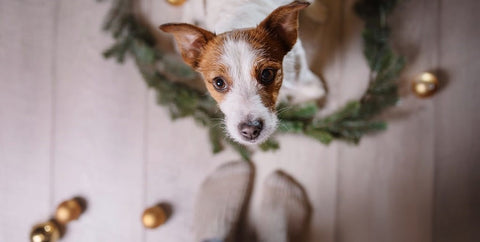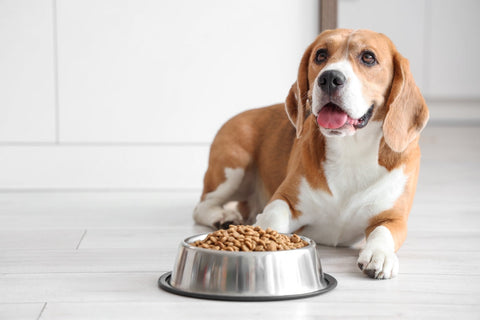

Swollen stomachs & bloat in dogs
Bloat isn’t just the canine version of eating too much during the holidays; it’s far more serious. While some stomach problems in dogs can be carefully monitored at home, bloat is not one of them. This is an emergency every single time. Let’s explore why.
What is bloat in dogs?
Bloat, or gastric dilation (GD), is when the stomach fills to a dangerous level, becoming overstretched with food, fluid or gas. Sometimes the cause is obvious (your pup has raided the food bin), but other times it develops without warning or a clear trigger.
An overfull stomach is dangerous on its own. It presses on the diaphragm, making it harder to breathe, and squashes key blood vessels running through the stomach wall. In severe cases, the stomach wall can even tear.
The danger increases dramatically when the stomach twists, a condition known as Gastric Dilation Volvulus (GDV) or “torsion”. You can’t predict if or when a dog’s stomach will twist, and you can’t spot it just by looking at your dog; an X-ray is normally needed to confirm it.
When twisting occurs, entry and exit from the stomach become blocked. Gas, fluid and food can’t escape, causing even more swelling. Blood flow may be completely cut off, and parts of the stomach can start to die. The spleen, which sits nearby, can also get dragged into the twist, and major blood vessels in the abdomen can be squashed, affecting the heart and circulation.
In these conditions, dogs can go into shock very quickly. It’s one of the most heartbreaking emergencies for owners, and because it can strike during the night or on an ordinary day while you’re at work, it often takes even the most experienced owner completely by surprise. Without surgery, a twisted stomach is fatal, and if too much damage has already occurred, euthanasia may be the kindest option.
Signs of bloat
In lean or short-haired dogs, swelling in the stomach area—just behind the last ribs—can be easy to spot. Visible bloat alone is enough to treat this as an emergency and pick up that phone; don’t wait to count the other symptoms on this list:
- Visible bloat: Distended, blown-out or puffed-up where the belly normally tucks in.
- Pain: Restlessness, shifting position, panting, or reacting to touch.
- Trying to vomit: Retching without bringing anything up.
- Drooling: Often due to nausea.
- Breathing difficulties: Caused by the stomach pressing on the diaphragm and by toxins from damaged tissue.
What causes bloat in dogs?
Exactly how bloat and stomach twisting develop isn’t fully understood, but certain risk factors are often seen in dogs who develop a GDV:
- Eating very quickly and/or eating very large amounts
- Also, eating from raised food bowls when it isn’t medically necessary
- Drinking a lot of water in a short time
- Exercise shortly after eating
- Stress and anxiety
- Breed: Deep-chested dogs—usually large or giant breeds—but even some small breeds with deep chests like dachshunds are at higher risk.
The risk also increases as your dog gets older.

Can a dog just be a little bloated?
Yes, mild bloating without a twist can happen. But there’s no safe way to tell at home whether a twist is present, or if it will develop, and things get worse scarily fast. Even if it turns out to be bloat, early intervention (like passing a stomach tube) can prevent a full-blown emergency.
What to do if you think your dog has bloat
Call your vet immediately.
How is bloat in dogs treated?
The first step is confirming whether the stomach has twisted—often via X-ray. It may be necessary to relieve a little pressure using a tube or needle, to buy time, while other tests are being run.
Bloat without twisting – Decompression, relieving the pressure, is the goal. This usually involves sedation or anaesthesia to pass a tube into the stomach and release trapped fluid, gas or food.
Bloat with twisting (GDV) – Emergency surgery is required to untwist the stomach. The vet will also perform a gastropexy: stitching the stomach to the abdominal wall to prevent another twist. Anaesthetics are more risky in these situations, but there is literally no alternative. Unfortunately, if the stomach or surrounding organs are too damaged, surgery may be unsuccessful or euthanasia may be the kindest choice.
Are some breeds more prone to bloat than others?
Yes. Deep-chested breeds are most at risk. Typically, large breed or giant dogs, often those that are a lot taller than they are wide—think Great Dane, German Shepherds, Weimaraners. But any breed can develop bloat or a GDV, and risk rises from middle age onwards.
Even small deep-chested breeds like Dachshunds or Basset Hounds are known to develop bloat, though fewer people are aware of this.
How to prevent bloat in the future
If your dog has surgery for a twisted stomach, gastropexy is usually performed at the same time, which is highly effective at preventing another twist. However, bloat (without twisting) can still happen.
Steps to reduce risk include:
- Use slow feeders, at floor level, to stop gulping
- Feed several smaller meals rather than one large meal
- Keep food securely stored to prevent accidental binges
- Manage drinking—don’t restrict overall daily water, but limit how much can be gulped at once
- Avoid vigorous exercise straight after meals (wait at least an hour)
- Manage stress, maintain a healthy weight, and support digestion (see our 5 Steps to Healthy Digestion)
The takeaway
Bloat can escalate from discomfort to life-threatening scarily fast. Early treatment gives the best chance of survival, so acting fast really could save your pup’s life. It’s a scary thought, but knowing what to do can give you some peace of mind. Being informed, spotting the warning signs, and understanding your dog’s risk factors are the best ways to prepare.
For more advice on keeping your dog happy and healthy, explore YuMOVE’s Health Guides.



